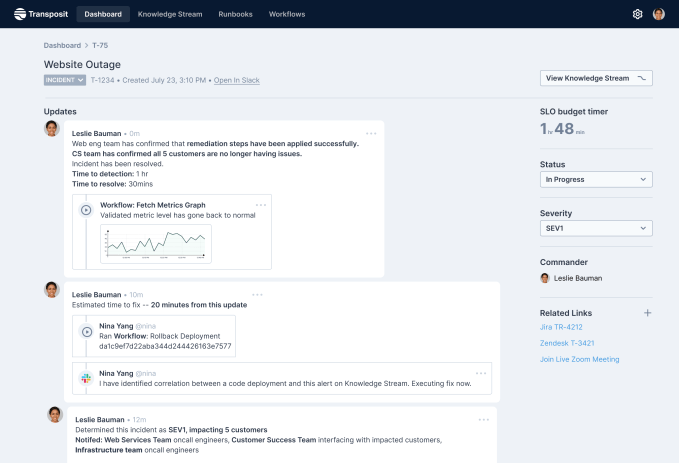01 Sep Transposit scores $35M to build data-driven runbooks for faster disaster recovery
Transposit is a company built by engineers to help engineers, and one big way to help them is to get systems up and running faster when things go wrong — as they always will at some point. Transposit has come up with a way to build runbooks for faster disaster recovery, while using data to update them in an automated fashion.
Today, the company announced a $35 million Series B investment led by Altimeter Capital with participation from existing investors Sutter Hill Ventures, SignalFire and Unusual Ventures. Today’s investment brings the total raised to $50.4 million, according to the company.
Company CEO Divanny Lamas and CTO and founder Tina Huang see technology issues as less an engineering problem and more as a human problem because it’s humans who have to clean up the messes when things go wrong. Huang says forgetting the human side of things is where she thinks technology has gone astray.
“We know that the real superpower of the product is that we focus on the human and the user side of things. And as a result, we’re building an engineering culture that I think is somewhat differentiated,” Huang told TechCrunch.
Transposit is a platform that at its core helps manage APIs, connections to other programs, so it starts with a basic understanding of how various underlying technologies work together inside a company. This is essential for a tool that is trying to help engineers in a moment of panic, figure out how to get back to a working state.
When it comes to disaster recovery, there are essentially two pieces: getting the systems working again, then figuring out what happened. For the first piece the company is building data-driven runbooks. By being data-driven, they aren’t static documents. Instead the underlying machine learning algorithms can look at how the engineers recovered and adjust accordingly.

Image Credits: Transposit
“We realized that no one was focusing on what we realize is the root problem here, which is how do I have access to the right set of data to make it easier to reconstruct that timeline, and understand what happened? We took those two pieces together, this notion that runbooks are a critical piece of how you spread knowledge and spread process, and this other piece, which is the data, is critical,” Huang said.
Today the company has 26 employees including Huang and Lamas who Huang brought on board from Splunk last year to be CEO. The company is somewhat unique having two women running the organization, and they are trying to build a diverse workforce as they build their company to 50 people in the next 12 months.
The current make-up is 47% female engineers, and the goal is to remain diverse as they build the company, something that Lamas admits is challenging to do. “I wish I had a magic answer, or that Tina had a magic answer. The reality is that we’re just very demanding on recruiters. And we are very insistent that we have a diverse pipeline of candidates, and are constantly looking at our numbers and looking at how we’re doing,” Lamas said.
She says being diverse actually makes it easier to recruit good candidates. “People want to work at diverse companies. And so it gives us a real edge from a kind of culture perspective, and we find that we get really amazing candidates that are just tired of the status quo. They’re tired of the old way of doing things and they want to work in a company that reflects the world that they want to live in,” she said.
The company, which launched in 2016, took a few years to build the first piece, the underlying API platform. This year it added the disaster recovery piece on top of that platform, and has been running it beta since the beginning of the summer. They hope to add additional beta customers before making it generally available later this year.
Sorry, the comment form is closed at this time.